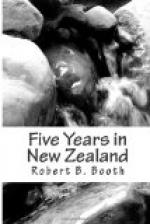I think it was the same night that we experienced a very heavy gale; the lightning, thunder, rain, and wind were terrific, and the sea ran mountains high. I stayed on deck nearly all the night, half perished with wet and cold; but such a storm carries with it a peculiar attraction, and one which I could not resist. I do not know anything more weird and impressive than the chant of the sailors hauling on the ropes, mingled with the fierce fury of the storm, and every now and again the dense darkness lit up by a vivid flash of lightning; the deck appears for the moment peopled by phantoms combined with the fury of the elements to bring destruction on the noble little vessel with its precious freight struggling and trembling in their grasp.
The following morning the storm had quite abated, but the sea was such as can be seen only in mid-ocean. Our little ship (she was only 700 tons) appeared such an atom in comparison with the enormous mountains of water. At one moment we would be perched on the summit of a wave, seemingly hundreds of feet high, and immediately below a terrible abyss into which we were on the point of sinking; the next we would be placed between two mountains of water which seemed going to engulf us.
I always took a place with the sailors on emergencies, to give a hand at hauling the ropes, and got to be fairly expert at climbing into the rigging. The rope-hauling was done to some chant started by the boatswain or one of the sailors—this is necessary to ensure that the united strength of the pullers is exerted at the same moment. One of the chants I well remember. It was:—
“Haul a bowlin’, the ‘Mary Anne’s’ a-rollin’. Haul a bowlin’, a bowlin’ haul; Haul a bowlin’, the good ship’s a-rollin’; Haul a bowlin’, a bowlin’ haul.”
The chant is sung out in stentorian notes by the leader, and on the word in italics every man joins in a tremendous and united pull.
Crowds of Cape pigeons and albatrosses accompanied us all across the South Pacific. These birds never seem to tire and but rarely rest on the water, except when they swoop down and settle a moment to pick up something that has been thrown overboard; this is quickly devoured, and they are again in pursuit. The albatrosses, some white, some grey, and some almost black, are huge birds; some that we shot, and for which the boat was sent, measured nine feet from tip to tip of wings.
On August 1st we rounded Stewart’s Island, the southern-most of the New Zealand group. It is little more than a barren rock, and was not then inhabited, whatever it may be now. Although it was the winter season, and the latitude corresponded to that of the North of England, we remarked how mild and dry was the atmosphere in comparison. Indeed the weather was glorious and seemed to welcome us to the land we were coming to.




